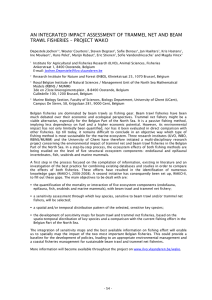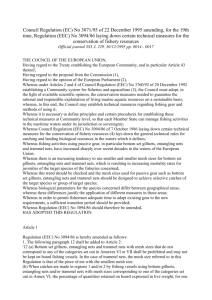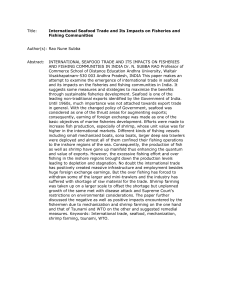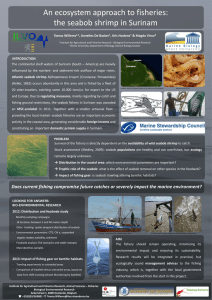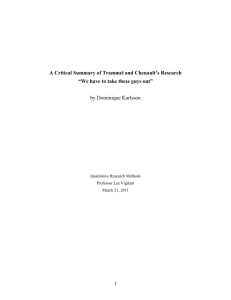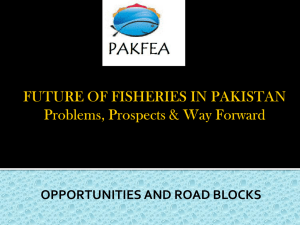TOWARDS SUSTAINABLE COASTAL FISHERIES DEVELOPMENT: A CASE IN
advertisement
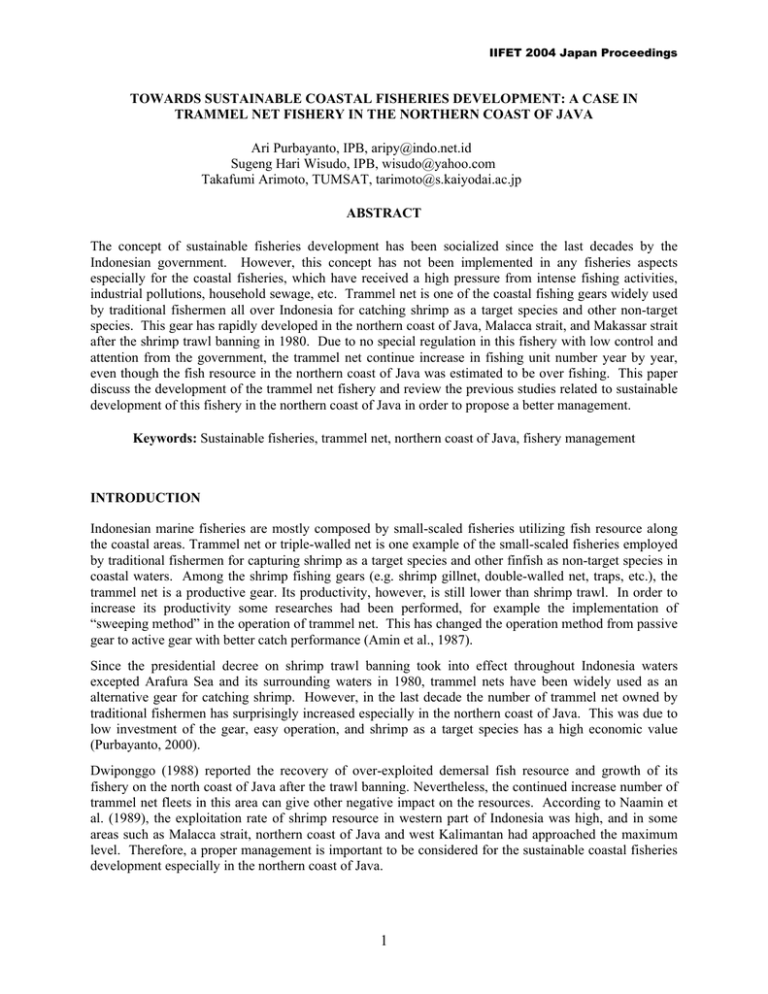
IIFET 2004 Japan Proceedings TOWARDS SUSTAINABLE COASTAL FISHERIES DEVELOPMENT: A CASE IN TRAMMEL NET FISHERY IN THE NORTHERN COAST OF JAVA Ari Purbayanto, IPB, aripy@indo.net.id Sugeng Hari Wisudo, IPB, wisudo@yahoo.com Takafumi Arimoto, TUMSAT, tarimoto@s.kaiyodai.ac.jp ABSTRACT The concept of sustainable fisheries development has been socialized since the last decades by the Indonesian government. However, this concept has not been implemented in any fisheries aspects especially for the coastal fisheries, which have received a high pressure from intense fishing activities, industrial pollutions, household sewage, etc. Trammel net is one of the coastal fishing gears widely used by traditional fishermen all over Indonesia for catching shrimp as a target species and other non-target species. This gear has rapidly developed in the northern coast of Java, Malacca strait, and Makassar strait after the shrimp trawl banning in 1980. Due to no special regulation in this fishery with low control and attention from the government, the trammel net continue increase in fishing unit number year by year, even though the fish resource in the northern coast of Java was estimated to be over fishing. This paper discuss the development of the trammel net fishery and review the previous studies related to sustainable development of this fishery in the northern coast of Java in order to propose a better management. Keywords: Sustainable fisheries, trammel net, northern coast of Java, fishery management INTRODUCTION Indonesian marine fisheries are mostly composed by small-scaled fisheries utilizing fish resource along the coastal areas. Trammel net or triple-walled net is one example of the small-scaled fisheries employed by traditional fishermen for capturing shrimp as a target species and other finfish as non-target species in coastal waters. Among the shrimp fishing gears (e.g. shrimp gillnet, double-walled net, traps, etc.), the trammel net is a productive gear. Its productivity, however, is still lower than shrimp trawl. In order to increase its productivity some researches had been performed, for example the implementation of “sweeping method” in the operation of trammel net. This has changed the operation method from passive gear to active gear with better catch performance (Amin et al., 1987). Since the presidential decree on shrimp trawl banning took into effect throughout Indonesia waters excepted Arafura Sea and its surrounding waters in 1980, trammel nets have been widely used as an alternative gear for catching shrimp. However, in the last decade the number of trammel net owned by traditional fishermen has surprisingly increased especially in the northern coast of Java. This was due to low investment of the gear, easy operation, and shrimp as a target species has a high economic value (Purbayanto, 2000). Dwiponggo (1988) reported the recovery of over-exploited demersal fish resource and growth of its fishery on the north coast of Java after the trawl banning. Nevertheless, the continued increase number of trammel net fleets in this area can give other negative impact on the resources. According to Naamin et al. (1989), the exploitation rate of shrimp resource in western part of Indonesia was high, and in some areas such as Malacca strait, northern coast of Java and west Kalimantan had approached the maximum level. Therefore, a proper management is important to be considered for the sustainable coastal fisheries development especially in the northern coast of Java. 1 IIFET 2004 Japan Proceedings This paper discuss the development of trammel net fishery and review the previous studies related to sustainable development of this fishery in the northern coast of Java in order to propose a better management. DEVELOPMENT OF TRAMMEL NET FISHERY Fishing Gear and Boat As one of the productive shrimp fishing gear, the trammel net showed rapidly development in number after the trawl banning in 1980. Among the class of gillnets, the trammel net posed the biggest number in the northern coast of Java in 2000 (11,263 units), followed by drift gillnet (10,433 units), set gillnet (8,174 units), shrimp gillnet (7,620 units), and encircling gillnet (695 units) as shown in Fig. 1 (Fisheries and Marine Affairs Department, 2002). Drift gillnet (10,433) Encircling gillnet (695) Shrimp gillnet (7,620) Set gillnet (8,174) Trammel net (11,263) Figure 1. Composition of Trammel Net and Gillnets in the Northern Coast of Java in the year of 2000 The development number of trammel net and other gillnets in the northern coast of Java on the last decade is presented in Fig. 2. From this figure, it can be seen that the number of trammel net was fluctuated year by year from 1991 to 2000 with the biggest number in 1997 (14,401 units) and the smallest number in 1993 (4,074 units). The number of this fishing gear during the period, however, showed the increasing trend. Like the trammel net, the number of gillnets were also fluctuated with slightly increasing trend excepted for drift gillnet that showed sharply decreasing trend. The drift gillnet posed the biggest number among the class of gillnets from 1991 to 1996. In 1997 and 2000, the biggest numbers was changed by the trammel net. While, in 1999 the shrimp gillnet was the biggest number of fishing gear among the class of gillnets. The gradual increase number of trammel net in the last decade might be stimulated by the recovery of demersal fish resource in the northern coast of Java as reported by Dwiponggo (1988). Beside that, trammel net was also considered as an inexpensive fishing gear that meets with economic condition of traditional fishermen, easy to operate, and catching a high value shrimp such as banana shrimp (Penaeus merguensis) and black tiger shrimp (Penaeus monodon) (Purbayanto, 2000). The trammel nets in the northern coast of Java are commonly operated using outboard wooden motor boat A few of them use inboard wooden motor boat of less than 10 tons. The development number of all outboard and inboard motor boats in the northern coast of Java during the period of 1991-2000 is shown in Fig. 3. Both the outboard and inboard motors showed the fluctuation with the biggest number occurred in 1999 (62,677 units for the outboard motors and 739 units for the inboard motors). However, the 2 IIFET 2004 Japan Proceedings overall boats showed their tendency to increase during that period. The trammel netters may posses some portions of the boats, but no available data, which are separated based on the types of fishing gear. 20 Number (thousand units) 18 16 14 Drift gillnet 12 Encircling gillnet 10 Shrimp gillnet Set gillnet 8 Trammel net 6 4 2 0 1990 1992 1994 1996 1998 2000 2002 Year Fleet number (thousand units) Figure 2. The Development Number of Trammel Net and Gillnets in the Northern Coast of Java during the Period of 1991-2000 70 60 50 40 Outboard motor Inboard motor (<20 GT) 30 20 10 0 1990 1992 1994 1996 1998 2000 2002 Year Figure 3. The Development Number of Outboard Motor and Inboard Motor Boat in the Northern Coast of Java during the Period of 1991-2000 Production The production of trammel net and other gillnets in the northern coast of Java during the last decade (1991-2000) are presented in Fig. 4. A slightly fluctuation of the trammel net production can be seen in this figure with the highest production in 1997 (27,547 tons) and the lowest in 1991 (5,979 tons). The overall productions of the trammel net during the period showed an increasing trend. Compared with the productions of other gillnets, the trammel net’s production was lower than the productions of drift gillnet 3 IIFET 2004 Japan Proceedings and shrimp gillnet, but it was higher than the productions of set gillnet and encircling gillnet. The productions of shrimp gillnet, set gillnet, and encircling gillnet showed a slightly increasing trend. In contrary, the production of drift gillnet showed the decreasing trend. 120,000 Production (tons) 100,000 Drift gillnet 80,000 Encircling gillnet Shrimp gillnet 60,000 Set gillnet 40,000 Trammel net 20,000 0 1990 1992 1994 1996 1998 2000 2002 Year Figure 4. The Productions of Trammel Net and Gillnets in the Northern Coast of Java during the Period of 1991-2000 Figure 5 shows the productivity (ton per number of fishing unit) of the trammel net and other gillnets. From this figure, we can know that the productivity of trammel net was lower than the productivities of other gillnets. The highest productivity was 3.33 tons/unit trammel net in 1993 or equal to 11.10 kg/trip/unit trammel net, and the lowest productivity was 0,55 tons/unit in 1991 or equal to 1.84 kg/trip/unit. Even with fluctuation, the productivity of trammel net still shows the increasing trend. The other gillnets (drift gillnet and encircling gillnet) showed high productivities, while the shrimp gillnet and set gillnet showed low productivities. The fluctuation of productivities also occurred in the gillnets, but only drift gillnet shows the increasing trend in productivity. Productivity (tons/unit) 10 8 Drift gillnet 6 Encircling gillnet Shrimp gillnet Set gillnet 4 Trammel net 2 0 1990 1992 1994 1996 1998 2000 2002 Year Figure 5. The Productivity (tons per unit) of Trammel Net and Gillnets in the Northern Coast of Java during the Period of 1991-2000 4 IIFET 2004 Japan Proceedings Nasution et al. (1984) revealed that the trammel net shrimp production in Eretan water, Indramayu of the northern coast of West Java was 3.19 kg/trip/boat with 10-15 net pieces during one-day fishing trip. Furthermore, Wudianto and Nasution (1986) reported that the catchability of trammel net with inner net of monofilament nylon (jaring tilek in Bahasa Indonesia) in Labuan water of Sunda strait was 94.2 g/piece/setting or 5.5 individual/piece/setting, which was higher than the catchability of trammel net with inner net of multifilament nylon. The trammel net with inner net of multifilament nylon (jaring kantong in Bahasa Indonesia) had the catchability of 36.4 g/piece/setting or 1.9 individual/piece/setting. A wide range of the trammel net productivity in the northern coast of Java (1.84-11.10 kg/trip/unit gear) is considered due to differences of (1) shrimp and fish resource abundance for each region (extend from Jakarta province to East Java province); (2) catchability of the trammel net used (different net pieces number and boat size); and (3) fishing effort (trip number, boat number or gear number) used for each year. Productivity (Rupiahs/units) The productivity (in rupiahs per unit gear) of the trammel net and other gillnets is presented in Fig. 6. This figure shows that the trammel net has high productivity in value especially in the year of 1993. From the year of 1994, the productivity looks to be stable. This condition is opposite with the low productivity in ton unit as mentioned before. The high productivity of the trammel net is caused by a high price of shrimp as the target catch in comparison to the price of fish as a common target catch of gillnets. This condition has to stimulate the fishers to increase the number of trammel net because they can earn more profit than they use the other gears. 100,000 80,000 Drift gillnet Encircling gillnet 60,000 Shrimp gillnet Set gillnet 40,000 Trammel net 20,000 0 1990 1992 1994 1996 1998 2000 2002 Year Figure 6. The Productivity (rupiahs per unit) of Trammel Net and Gillnets in the Northern Coast of Java during the Period of 1991-2000 OPERATION METHOD AND CATCH COMPOSITION Operation Method Based on the net webbing used, there are three kinds of the trammel nets, i.e. monofilament net, multifilament net, and combination of monofilament and multifilament trammel net. The operation method of the gear can be categorized into passive and active method. The passive method is when the net set on seabed fishing ground and drifted by current. While, the active method is when the net towed 5 IIFET 2004 Japan Proceedings encircling and swept over the sea bottom of fishing ground. This method is thereafter known with “sweeping method” (Wudianto and Nasution, 1991; Purbayanto, 2000; Purbayanto et al., 2000a). The sweeping method had been proved to have a better catch than the passive method (Wudianto, 1985). Moreover, Wudianto et al. (1988) reported that monofilament trammel net showed a good catch performance compared to multifilament trammel net. Even the productivity of trammel net using sweeping method and monofilament nylon material become increased, however, the increase of this productivity was considered still low. Beside that, some problems arose such as the increase of net broken during operation, catch damage, and difficulty to handling the net during hauling process (Amin et al., 1987). Indeed, the fishers in the northern coast of Java continued to use the trammel net by implementing the sweeping method and mostly using monofilament nylon webbing as the material of inner net. A recent year developed mini trawl (modification of bottom seine net) targeting shrimp in the northern coast of Java perhaps will change the mode of fishers from using the trammel to mini trawl. This condition can be predicted because the mini trawl is a productive coastal fishing gear so far. However, the mini trawl is prohibited according to the government regulation; therefore some additional problems may occur soon in this coastal area. Catch Composition Shrimp is a main target species of the trammel net, although various fish species are also caught as nontarget species. The kind of shrimp species commonly caught by this gear are banana shrimp (Penaeus monodon), tiger shrimp (Penaeus monodon), and endeavor shrimp (Metapenaeus sp.). While, non-target species commonly caught are amoy croaker (Argyrosomus amoyensis), jewfish (Johnius dussumieri), and tongue sole (Cynoglossus spp.). Purbayanto (2000) reported that during one fishing trip of trammel net in Muara Reja water, Tegal city, the catch was dominated by manthis shrimp (Squilla sp.) and amoy croaker (Argyrosomus amoyensis). The other shrimp and fish caught were banana shrimp, black tiger shrimp, Setipinna breviceps, Kowala coval, pomfret (Stromateus cinereus), Scatophagus argus, conger eel, and cuttle fish (Sepia sp.). Amin et al. (1987) reported that the operation of two kinds of the trammel nets with various mesh size and different webbing material in Labuan water, West Java harvested shrimp as the main catch, and finfish, squid, swimming crab, etc. as the by-catch. The shrimp was dominated by banana shrimp, Metapenaeus sp., and black tiger shrimp. The by-catches were tongue sole, grouper (Epinephelus sp), Psettodes sp., amoy croaker, squid, swimming crab, etc. Barus et al. (1986) reported that the fishing experiment using trammel net in Ciasem Bay, West Java harvested 7 species of shrimp catch and 24 species of fish catch. The shrimp were Metapenaeus brevicornis (26.66%), Metapenaeus monoceros (0.20%), Metapenaeus lyssiana (0.04%), Penaeus merguensis (0,60%), Penaeus monodon (0.10%), Parapenaeopsis sculptilis (0.03%), and other shrimps. The dominant by-catch species were Arius sagor (7.94%), Arius thallasianus (6.80%), Arius spp. (4.31%), Johnieopsvulgeri sp. (6.86%), and Cynoglossus sp. (1.78%). A recent result on catch composition of the trammel net during fishing operation from April to July 2002 in Muara Reja water, Tegal city, Central Java is described below (Purbayanto et al., 2003). The number of species caught in April were 16 species with the dominant species of Argyrosomus amoyensis (59.48%), Arius sp. (17.14%), Thryssa mystax (12.47%), Leiognathus sp. (2.08%), Cynoglossus sp. (2.08%), Squilla sp. (1.82%), and Penaeus merguensis (0.78%). The catches in May were 11 species with the dominant species of A. amoyensis (61.54%), Arius sp. (19.71%), P. merguensis (4.81%), Cynoglossus sp. (3.37%), and T. mystax (3.37%). The catches in June were 18 species with the dominant species of A. amoyensis (40.15%), P. merguensis (15.19%), Squilla sp. (9.49%), S. argus (6.33%), and P. sanguinolentus (5.09%). The catches in July were 41 species with the dominant species of A. amoyensis 6 IIFET 2004 Japan Proceedings (41.74%), T. mystax (12.59%), Squilla sp. (13.86%), S. argus (4.68%), Arius sp. (4.47%), and P. merguensis (3.78%) as shown in in Fig. 7. P . mo no do n 3.79 P . merguensis July 2002 Total catch = 2 368 indiv. 13.86 Squilla spp Sto lepho rus sp A . leio gaster L. jo hnii 1.98 Sillago sihama E. lepturus Sardinella sp 1.43 P . sanguino lentus 2.11 Leio gnathus sp G. minuta A . kleinii H. gerardi 1.52 Glassfish 4.47 A rius sp 2.91 Cyno glo sus sp Cyno glo sus sp 4.68 S. argus Terapo n sp A . leuco grammicus Scylla spp Rastrelliger sp L. lentjan A . melano phera G. griseus G. filamento sus S. baracuda A . mate I. malasto ma 41.74 A . amo yensis P . kaakan 1.22 E. tetradactylum C. sexfasciatus C. feriata 12.59 T. mystax V. speigleri P . argentus B . trispinesus Drepane sp 1.73 S. pharao nis 0 10 20 30 40 50 60 70 80 90 100 Percent individual Figure 7. The Catch Composition of Trammel Net in Muara Reja, Tegal City, Central Java Based on the Experimental Fishing Operation in July 2002 7 IIFET 2004 Japan Proceedings SELECTIVITY PERFORMANCE In general, selectivity of the trammel net for finfish depends on mesh size and vertical slackness of its inner net. Some studies reported that mesh selectivity curve of the gear skewed to the right side and had a wider selection range of 50% relative efficiency with the increased of slackness (e.g. Kitahara, 1968; Koike and Matuda, 1988; Losanes et al., 1992; Fujimori et al., 1996). Purbayanto et al. (2000b) reported that the selectivity curve of sweeping trammel net for Japanese whiting (Sillago japonica) in Tateyama Bay Chiba Prefecture showed a wide selection range of 50% relative efficiency (the selection range was 5.4-7.4 in length ratio to the mesh length l/m). It meant that the trammel net in Tateyama Bay caught a large number of entangled and pocketed fish in comparison to the gilled fish due to the effect of inner net slackness. Only a few studies on the selectivity of trammel net have been conducted in Indonesia. Murdiyanto (1990) from his study concluded that the different mesh size or hanging ratio of trammel net in Labuan water, West Java gave a significant difference of shrimp and finfish catch. The trammel of 1.5 inches mesh size gave the biggest catch result compared to the catch of 1.75 inches and 2.0 inches mesh sizes. Meanwhile, the trammel net of 1.75 inches and 2.0 inches mesh sizes showed the better mesh selectivity. In addition, increasing or decreasing 10% of hanging ratio, which commonly used by the trammel net’s fishermen in Labuan water did not show the different catch both for shrimp as the main target catch or finfish as the by-catch. Other selectivity research on the trammel net for banana prawn (Penaeus merguensis) in Pelabuhan Ratu Bay has been reported by Yokota et al. (2003). Our recent results on mesh selectivity of the trammel net for two dominant non target species, i.e. amoy croaker (Argyrosomus amoyensis) and moustached thryssa (Thryssa mystax) in Muara Reja water, Tegal City, Central Java are described below. The increase of inner net mesh size significantly increased the length distribution of croaker. However, it did not significantly increase the length distribution of moustached thryssa. This means that the trammel nets only had mesh selectivity to croaker. Matsuoka (1995) explained that the most important factor influencing selectivity is mesh size besides the net webbing. Moreover, the way of fish being caught in the net is also influencing the mesh selectivity. In case of moustached thryssa, the selectivity mechanism of the trammel net did not work properly due to most of fish (51.17%) being entangled in the mesh twine on their mouth. As plankton feeder, moustached thryssa opened their mouth during swimming so that the probability of fish being entangled in the net on their mouth was high. While, the most of croaker was gilled (65.09%) and only 25.93% of the fish was entangled. According to the net webbing used, the number of croaker caught in the multifilament nylon was larger than in the monofilament nylon. It can be considered that the catch ability of the multifilament nylon was better than the monofilament nylon for gilled capture. Nomura and Yamazaki (1977) explained that the monofilament nylon net has higher elasticity than the multifilament nylon net of the same measurement. The net elasticity has a great influence on the mesh selectivity for fish caught by entangled, but does not give a high influence for fish caught by gilled condition. This explanation supports the present result, which showed large number of craoker were caught by gilled in the multifilament nylon. Whilst moustached thryssa caught in a large number by entangled in the monofilament nylon may be due to its high twine elasticity. The master selectivity curves of the trammel nets were asymmetric, but tended to be normal curves. The left sides of the curves were slightly flatter than the right sides as the nets were more efficient to catch a small croaker than the large one (Fig. 8). From the view point of selection range of 50% relative efficiency, the master selectivity curves for amoy croaker were broader selection range than the selectivity curves for Japanese whiting (Purbayanto et al., 2000b). Moreover, the multifilament trammel nets were more selective than the monofilament nylon for croaker as shown by the slim curve with narrow selection range of 50% relative efficiency. 8 IIFET 2004 Japan Proceedings The plots data showing the relationships between relative efficiency and total length ratio to mesh size of the multifilament and monofilament nylon for moustached thryssa were presented in Fig. 9. By looking these figures, we can know that the plots data were scattered. This implies that the selectivity curves for moustached thryssa estimated using a polynomial model could not be drawn. Figure 8. The Master Curves of Mesh Selectivity of the Trammel Nets (Multifilament and Monofilament Nylon Inner Nets) in Term of Length Ratio to Mesh Size (l/m ratio) for Amoy Croaker Figure 9. The Relationship between Relative Efficiency and l/m Ratio of the Trammel Nets for Moustached Thryssa PROPOSING FOR FUTURE MANAGEMENT Improving fishing gear selectivity is the first option for the better resource management, and second establishing the effective release method as an alternative option can be considered if the fishing gear selectivity is low. With recent increasing needs on resource management for the sustainable coastal fisheries, these options are of urgent importance to be implemented. The important of mesh selectivity for management purpose is to set a minimum mesh size for ensuring that fish have spawned at least once before being harvested (Purbayanto et al., 2000b, 2001). In this concern, management policies respecting to sustainable fisheries in Indonesia are as follows (Widiana, 1997): (1) fishing zone policy, (2) mesh regulation, e.g. prohibited mesh size of less than 2.5 9 IIFET 2004 Japan Proceedings cm in general and less than 6 cm for tuna and skipjack purse seine, (3) taken fisheries allocation policy: fisheries resource evaluation, comprising of information on fisheries utilization, potential yield (MSY), exploitation level, and resource allocation on the basis of fishing license, (4) regulation for fishing vessel, (5) management for fish aggregating device (FAD), (6) Fisheries Law 1985, (7) MCS related to Indonesian EEZ law 1983, (8) local community convention (e.g. awig-awig, sasi, panglima laut, etc.), (9) regulation for by-catch utilization, and (10) BED-shrimp trawl regulation. Those management policies, however, are too general so that they are difficult to be implemented in the real condition of the fisheries. In addition, there is no regulation for a specific fishery, such as the trammel net fishery in the northern coast of Java. The available local community conventions, however, are only run in certain coastal communities. In this respect, the important problems may be the less understanding of coastal fishermen on the sustainability of fish resources and the low attention of the government to the coastal fisheries. While, the worse law enforcement in this country also contributes to unworkable of the fisheries management system in general. As the recommended fishing gear, trammel net is considered to be suitable for Indonesian small-scaled coastal fisheries. Recent degradation on coastal water quality, the increase of the trammel net fleet especially in densely areas of northern coast of Java, and also because unworkable of the coastal management system will thread the sustainability of the resources. Therefore, the future development of the trammel net fishery must be not to increase its productivity but should be directed to improve its selectivity performance followed by decreasing the number of non-target catch. In addition, some special regulations on this fishery should be reconsidered, those are (1) to limit the number of coastal trammel netter by prohibiting new outboard motor or changing the outboard to inboard motor for offshore fishing ground, (2) setting the fishing area for the trammel net and other active fishing gears (i.e., within the area of 2-4 miles), (3) consistency in law enforcement, and (4) educate the fishermen to increase their awareness to conserve fish resource and its environment. CONCLUSIONS Even with the increased trend of the trammel net’s productivity during the last decade, the continued increasing number of the gear in the northern coast of Java can threat the second tragedy on depletion of coastal fish resources and the gear competition with finally to generate social unrest. The management measure on mesh selectivity of the trammel net fishery can be implemented by enlarging the mesh size and the use of multifilament nylon material for the inner net. A special regulation on the trammel net fishery are important to be reconsidered such as (1) to limit the number of fishing fleets, (2) setting the specific fishing area, (3) consistency in law enforcement, and (4) educate the fishermen to increase their understanding of the importance of fish resource and its environment for the next generation. REFERENCES Amin, Edi M., Kusno Susanto, and Heri H. Latief, 1987. The Effect of Twine Size and Mesh Size of Trammel Net on Shrimp Catches. Marine Fisheries Research Journal, Marine Fisheries Research Institute, Jakarta, No. 38, pp. 1-11. Barus, Herry R., Mahiswara, and Wasilun, 1986. Experimental Fishing of Trammel Net in Ciasem Bay, West Java. Marine Fisheries Research Journal, Marine Fisheries Research Institute, Jakarta, No. 36, pp. 49-56. Dwiponggo, A., 1988. Recovery of Over-Exploited Demersal Resource and Growth of Its Fishery on the North Coast of Java. IARD Journal Vol. 10 No. 3, pp. 65-72. 10 IIFET 2004 Japan Proceedings Directorate General of Fisheries, 1991-1999. Indonesian Fisheries Statistic. Department of Agriculture, Jakarta. Department of Fisheries and Marine Affairs, 2000-2002. Indonesian Fisheries Statistic. Jakarta. Fujimori, Y., T. Tokai, S. Hiyama, and K. Matuda, 1996. Selectivity and Gear Efficiency of Trammel Nets for Kuruma Prawn (Penaeus japonicus), Fish. Res., 26, pp. 113-124. Kitahara, T., 1968. On Sweeping Trammel Net (Kogisasiami) Fishery along Coast of the San-in District III: Mesh Selectivity of Sweeping Trammel Net for Branquillos. Nippon Suisan Gakkaishi, 34, pp. 759-763. Koike, A. and K. Matuda, 1988. Catching Efficiency of Trammel Net with Different Vertical Slackness and Mesh Size of Inner Net. Proceedings of the World Symposium on Fishing Gear and Fishing Vessel Design, Marine Institute St. John’s, Newfoundland, Canada, pp. 468-470. Losanes, Loel P., K. Matuda, T. Machii, and A. Koike, 1992. A Catching Efficiency and Selectifity of Entangling Nets. Fish. Res., 13, pp. 9-23. Murdiyanto, B., 1990. Study on the Relation of Trammel Net Mesh Size and Hanging Ratio to the Catch in Labuhan, West Java. Maritek Buletin, Marine Science and Technology Study Program, Faculty of Fisheries, Bogor Agricultural University, 4(1), pp. 1-29. Matsuoka, T., 1995. Selectivity of fishing gear and its application for sustainable development of fisheries. Kagoshima University, Japan. 31p (unpublished). Purbayanto, A., 2000. Trammel Net Fishery in Indonesia: Present Status and Development Prospect in the 21st Century. Proceedings of the Fourth Symposium on Agri-Bioche, Tokyo. Purbayanto, A., Seiji Akiyama, Takafumi Arimoto, and Muhammad F.A. Sondita, 2000a. Capture Process of Sweeping Trammel Net with Special Reference on Operation Method and Catch Pattern. In: Arimoto T., and J. Haluan (eds.). Proceedings of the 3rd JSPS International Seminar on Fisheries Science in Tropical Area, TUF-JSPS International Project, Tokyo University of Fisheries, Tokyo, Vol. 8, pp. 98-103. Purbayanto, A., Seiji Akiyama, Tadashi Tokai, and Takafumi Arimoto, 2000b. Mesh Selectivity of A Sweeping Trammel Net for Japanese whiting Sillago japonica. Fisheries Science, 66(1), pp. 97103. Purbayanto, A., Muhammad Imron, and Wasmen Manalu, 2003. Conservation of Coastal Fisheries Resource through Improvement of Mesh Selectivity of Trammel Net and Survival of Non Target Species. Research Report of RUT-IX, Ministry of Research and Technology, Institute of Science and Technology, Indonesia. Wudianto and Chairul Nasution, 1991. Catch-Rates by Parts of Pieces of Trammel Net According to Their Position to the Fishing Boat. Marine Fisheries Research Journal, Marine Fisheries Research Institute, Jakarta, No. 60, pp. 37-49. Wudianto, 1985. An Experiment on the Operation Method of Pocket Net (Jaring Kantong) in Banten water. Marine Fisheries Research Journal, Marine Fisheries Research Institute, Jakarta, No. 33. Wudianto, Agustinus P.A. Widodo, and Chairul Nasution, 1988. The Effect of the Use of Monofilament Twine as Material of Trammel Net to Banana Shrimp Catch. Marine Fisheries Research Journal, Marine Fisheries Research Institute, Jakarta, No. 48. Widiana, K., 1997. Status of fishing condition in Indonesia in relation to responsible fishing. Proceeding of the Regional Workshop on Responsible Fishing, Bangkok. Yokota, K., Ari Purbayanto, and Muhammad Fedi A. Sondita, 2003. Selectivity of a trammel net for banana prawn Penaeus merguensis in Pelabuhan Ratu water of West Java, Indonesia. Journal of Aquatic Sciences and Fisheries Indonesia, Jilid 10 No. 1, pp. 57-63. 11
